This mango pavlova is a gorgeous, ethereal looking meringue with a soft centre and loaded with toppings that will make you feel like you’re somewhere tropical and sunny.
It all starts with the best pavlova recipe. You want it to have a thick, crunchy crust of meringue on the outside but the inside absolutely must be filled with soft and fluffy, almost marshmallow-like filling. Then you need to load it up with cream and fresh fruit. With this one, I chose mango, mango curd and even a little drizzle of my mango syrup.
Fact: While it is the perfect summer dessert, you do not need to be in the height of summer to enjoy this mango pavlova. While fresh mangoes are great for topping, you can used tinned mango slices and I almost always make my mango curd with frozen mango. Or choose another fruit and enjoy!
My perfect pavlova recipe is fool-proof and has all the tips you need and a troubleshooting guide to help you perfect your own pavlova at home.
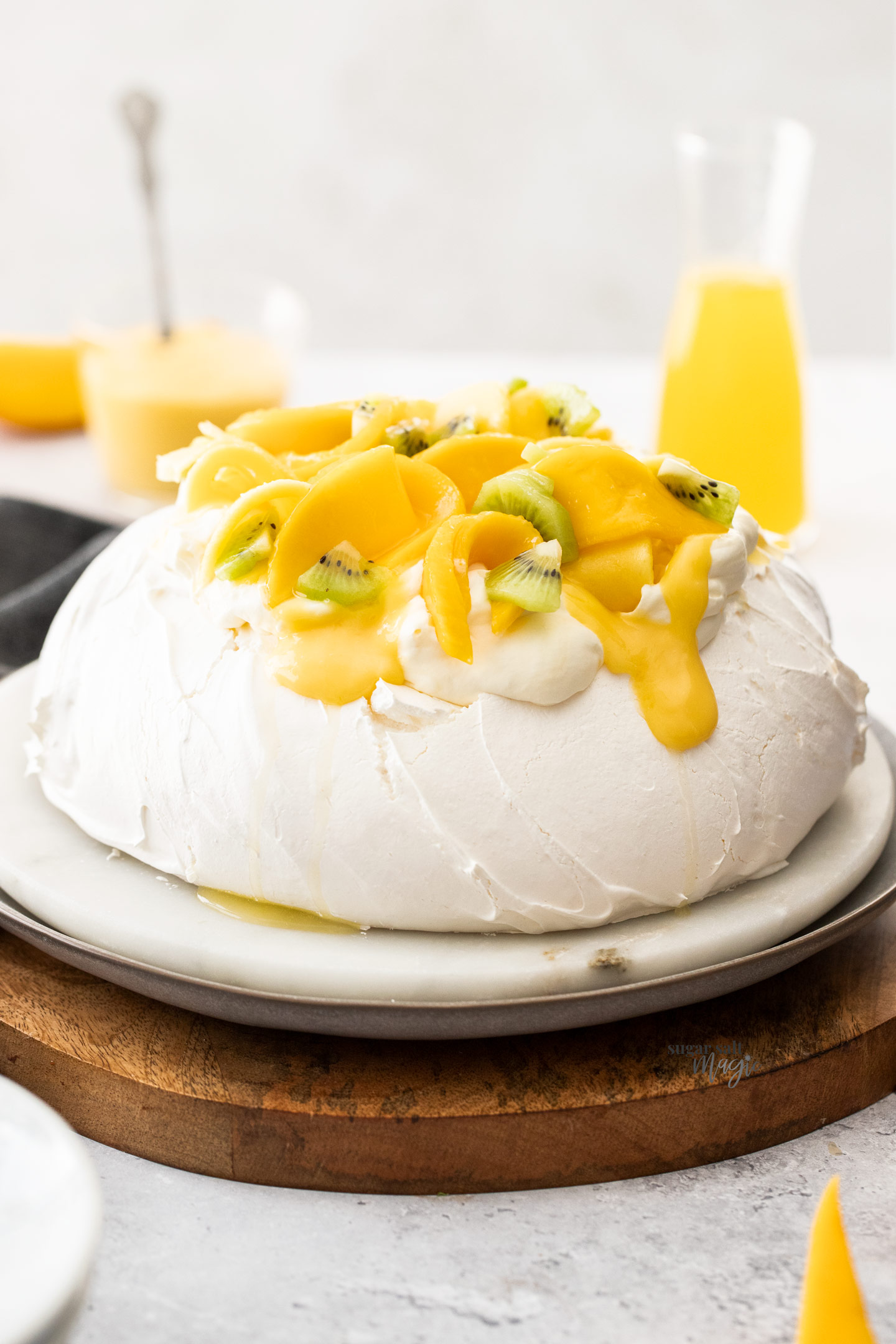
Never Miss a Recipe!
Get the latest recipes straight to your inbox!
Ingredients in pavlova
You can’t wrong with a dessert that requires just 4 base ingredients then any topping you want to add.
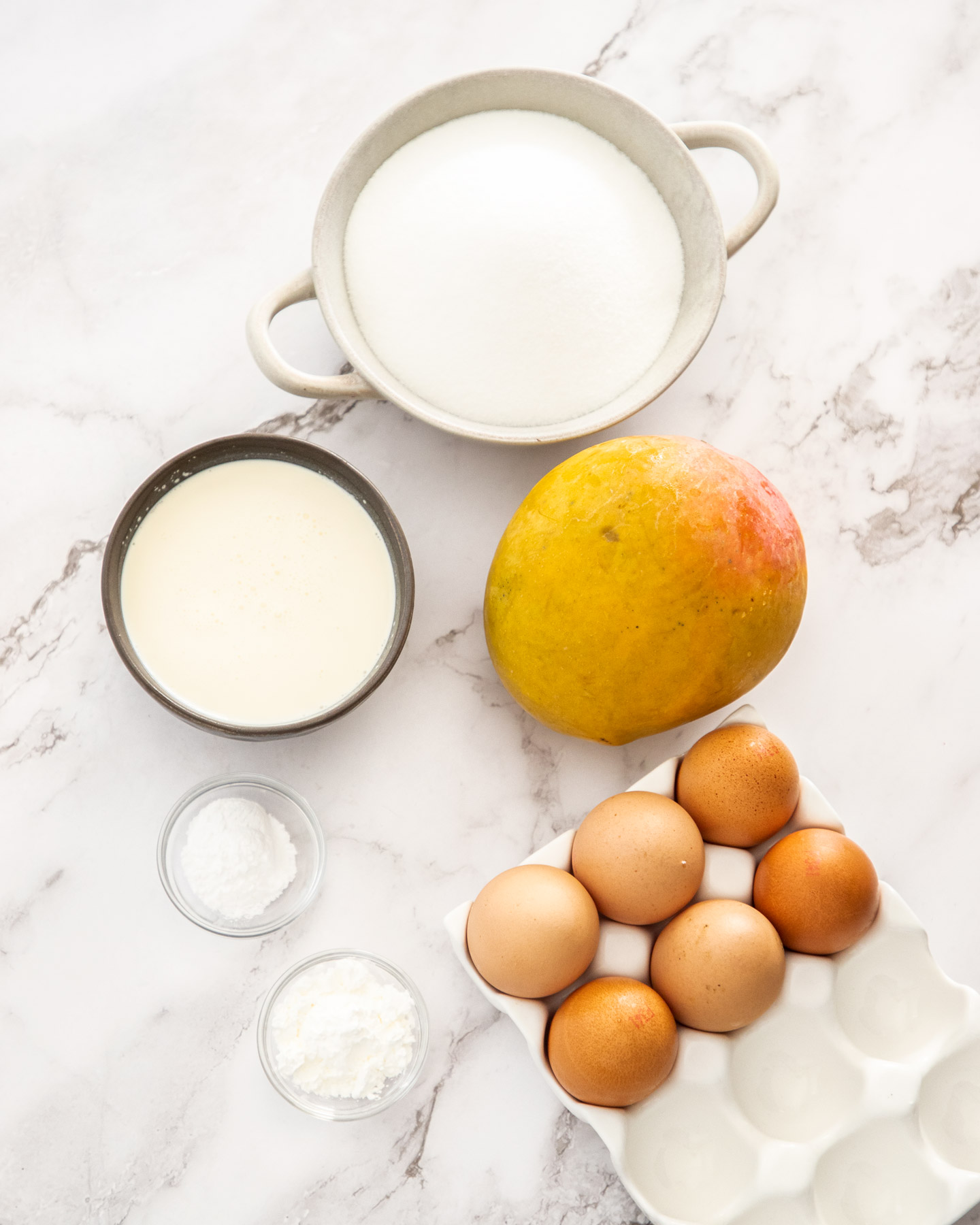
Detailed quantities and instructions in the recipe card below.
- Eggs: Eggs that are a little older are better than fresh eggs and you want to measure them into a ¾ cup measure to get the correct volume. You’ll get the most volume from room temperature eggs.
- Sugar: Make sure to use caster sugar / superfine sugar (NOT icing sugar / powdered sugar). The finer grain of the sugar allows it to dissolve into the egg whites more quickly. If you use regular granulated sugar, you may find that you have to overwhip the eggs to get the sugar to dissolve.
- Cream of tartar: Adding an acidic ingredient to the pavlova helps with stability of the egg whites. While you can use lemon juice or vinegar, I like to use cream of tartar so that I’m not introducing liquid to the meringue.
- Cornflour / cornstarch: The same as what’s known in the US as cornstarch, cornflour is normally used for thickening. In a pavlova, it not only helps with stability but also with that fluffy interior too.
- Toppings: You must always have unsweetened whipped cream – it balances out the sweetness of the pav. Then typically loads of fresh fruit. I chose mango then dialled that flavour up by adding my mango curd and mango syrup. I also added some kiwi fruit for colour.
How to make pavlova (step-by-step)
Pavlova is not as difficult as it first looks; just make sure you stick to the steps and you got this!
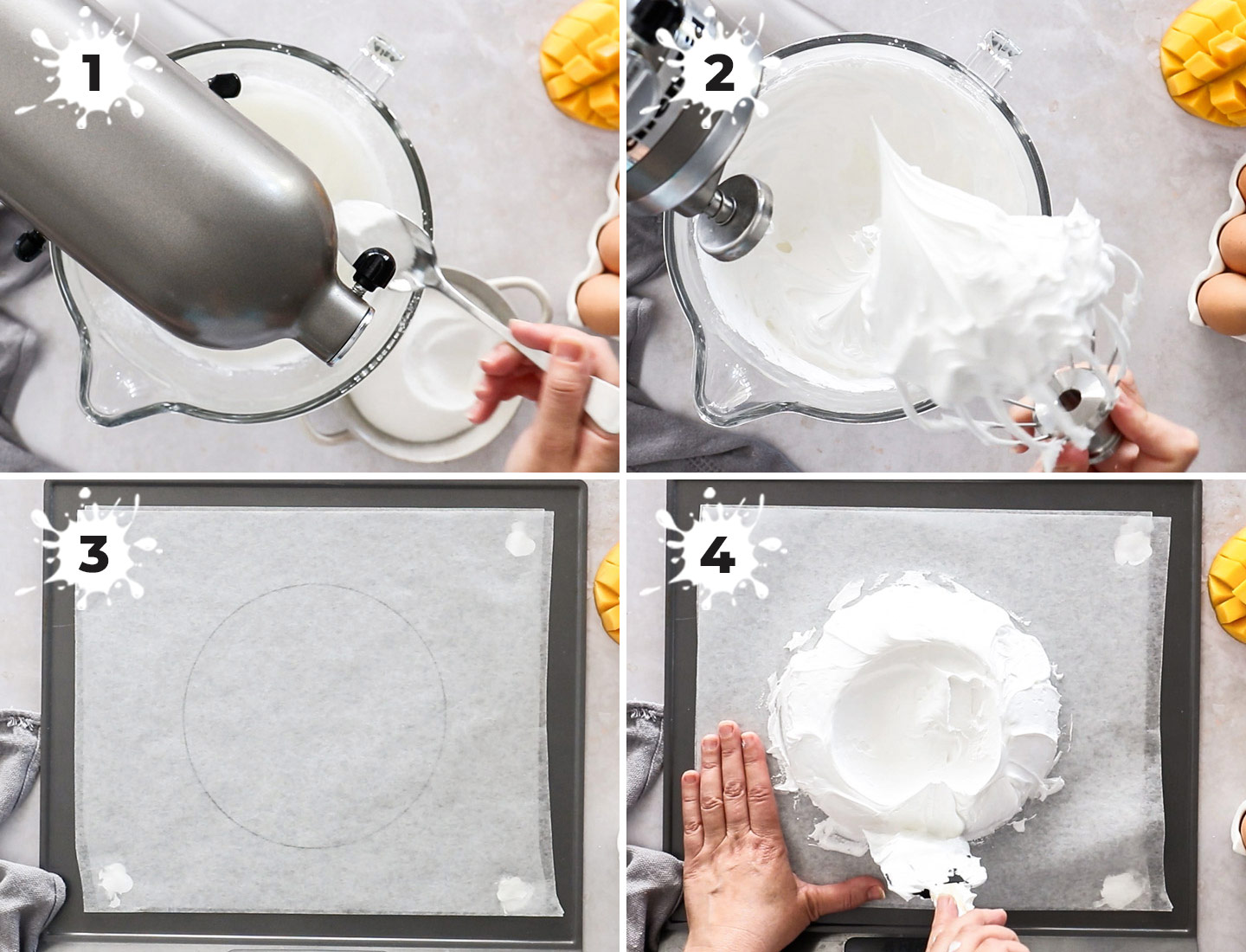
Detailed quantities and instructions in the recipe card below.
- Eggs to soft peaks: Beat egg whites until you have white soft peaks (2-3 minutes), then sift over the cream of tartar and cornflour, then start beating on low.
- Add sugar: Very slowly add the sugar – just 1 tablespoon at a time and counting to 20 before adding the next.
- Beat to stiff peaks: Now turn the mixer up to medium-high (NOT the highest setting) and beat until the mixture is glossy, thick and has stiff peaks when you remove the whisk.
- Shape it: Tip the meringue mixture onto a baking tray lined with baking paper and bake low and slow.
- Cool it slowly: Let the pavlova cool in the oven as the oven cools for at least 2 hours. From there you can either just leave it there overnight or wedge the door open for another 1 hour before taking it out and store it somewhere cool like the pantry (not in the fridge).
- Decorate the pavlova: Whip up some cream but don’t sweeten it or the whole pavlova will be too sweet. Add some curd or just some passionfruit pulp, then top it with mango (or your favourite fruits).
Tips and tricks
- You can overbeat pavlova: Don’t just beat your egg whites on high because you’ll end up with whites that are overwhipped and sugar that hasn’t dissolved. That will result in a cracked, weepy pavlova. Better to beat low over a longer period of time than rush it.
- Don’t add the sugar too early. You need the eggs to get a little structure before adding the sugar so get them to soft peak stage, then start making additions.
- Add the sugar slowly: You just want to add one tablespoon at a time and count to 20 before adding the next. This step should take 7-10 minutes but is important for both dissolving the sugar and gradually building the structure of the egg whites.
You can check out more tips and tricks and my troubleshooting guide in my how to make perfect pavlova post.
Important note: Pavlovas crack and it’s totally ok. By design, it’s nigh on impossible not to get a crack on a large pavlova. Big cracks can be prevented through following the steps closely but, since there is often a gap between the soft filling and the crunchy outside, the top is likely to crack and fall in. That is totally fine. Don’t let anyone tell you that you should strive for a perfect pavlova with absolutely no cracks.
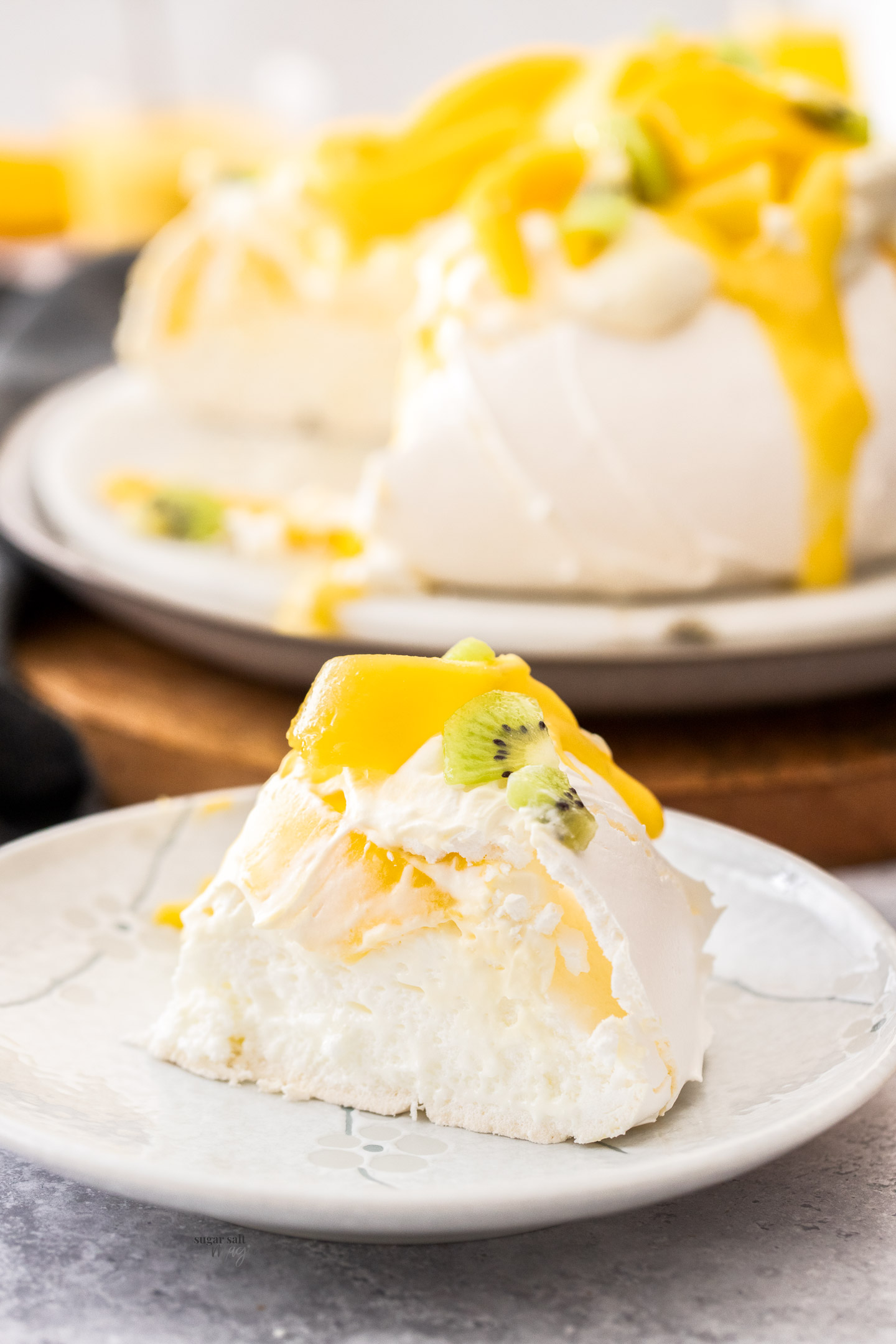
How to cut mango for pavlova
There are so many ways you can slice your mango to top your pavlova.
- Cubes: Cut the cheek off the mango by slicing down past the seed, then score through the flesh in a grid pattern without cutting through the skin. Now push the skin inside out and slice off the cubes.
- Slices: I have done slices on my mango pavlova that are swirled here and there. Simply cut the cheek off a mango, slicing down past the seed, then place the edge of the mango slice on the edge of a glass. Press down so that the flesh goes in the glass while the skin remains in your hand on the outside. Now just use a sharp knife to slice it thinly.
- Wedges: Just slice off the cheek, cut into 3-4 wedges, then run a knife between the flesh and the skin.
FAQs
Yes, this mango pavlova is gluten-free so long as you use gluten-free cornflour.
Pavlova has referred to a number of desserts over the years but this version, with a big meringue with a fluffy interior, topped with cream and fruit was invented in Perth, Western Australia and named as such for a ballerina doing a tour at that time.
Pavlova is actually a type of meringue but if we’re referring to the finished article being called meringue, they are crisp all the way through and don’t have the fluffy centre that a pavlova does.
Yes, in fact it’s best to make a pavlova the day before – without the topping. You can cook a meringue and leave it in the cooled oven overnight. Wherever you leave it, they do take a while to cool so to make it all on one day you would need to start early.
Yield and storage
This pavlova will serve 8-10 people.
Don’t decorate your pavlova until closer to serving time as the cream will soften the crunchy parts.
Once topped with cream and fruit, if you have leftovers, store them in an airtight container for up to 3 days. It will soften over this time.
You can make the pavlova shell ahead of time and store it in an airtight container in a cool place like the pantry or linen closet for 1-2 days. You can also freeze the pavlova shell for up to 3 months in an airtight container.
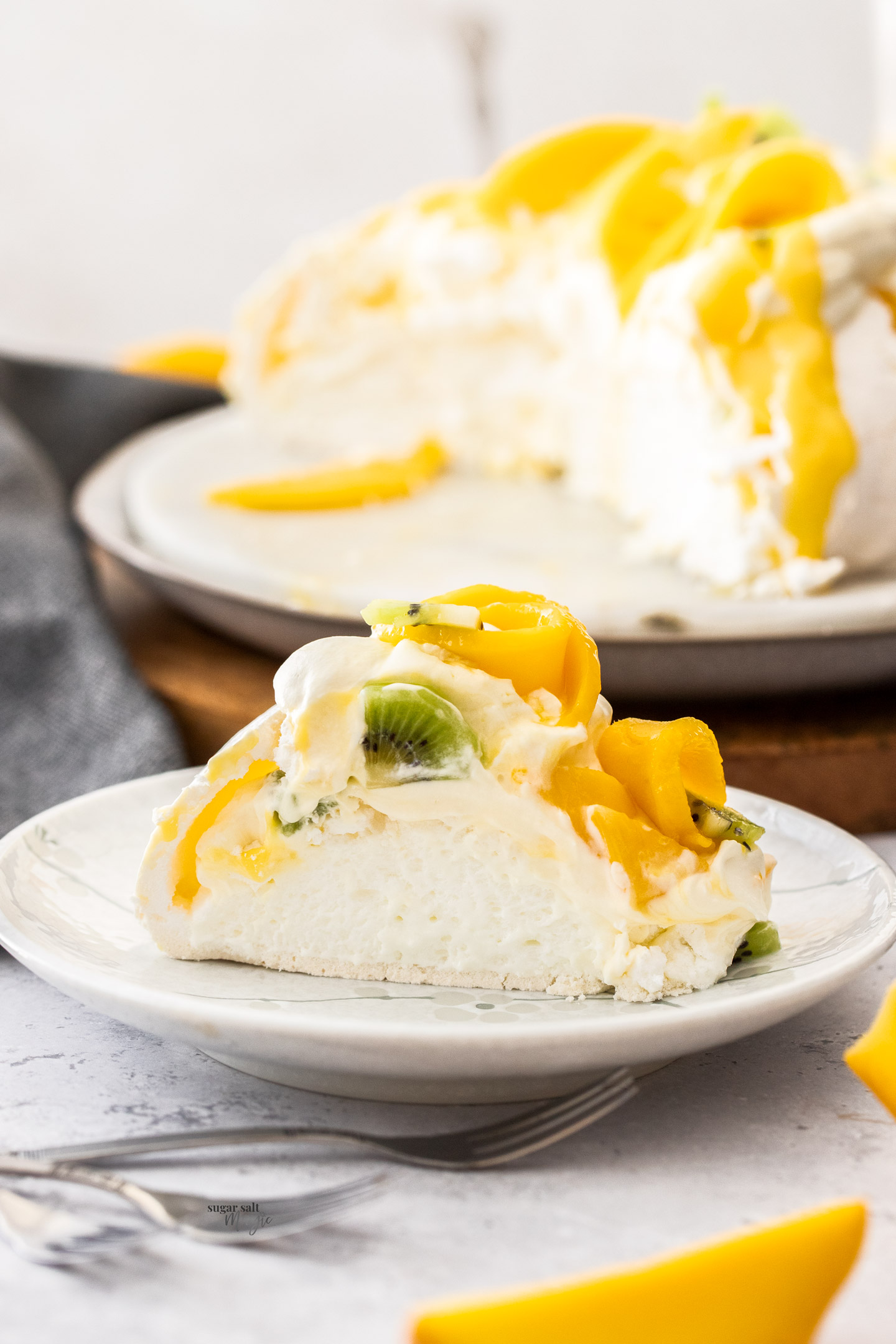
Did you try this mango pavlova recipe?
Leaving a rating and comment below the recipe is so helpful!
Hungry for more? Subscribe to the newsletter for free recipes straight to your inbox. Also, follow along on Facebook, Pinterest and Instagram.
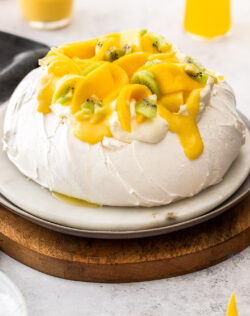
Ingredients
FOR THE PAVLOVA BASE
- ¾ cup egg whites (approximately 6 large eggs), room temp
- 1 ½ cups caster sugar (superfine sugar ) (300g / 10.5oz) (notes)
- 3 teaspoons corn flour (cornstarch)
- 1 ½ teaspoons cream of tartar (notes)
FOR TOPPING
- 1 cup thickened cream (or whipping cream / heavy cream) (250ml)
- 1 large mangos, peeled and sliced thinly
- ⅓ cup mango curd, optional
For best results, always weigh ingredients where a weight is provided
Equipment
- Stand mixer with whisk attachment (best)
- Electric mixer and large bowl (second best)
- Spatula
Instructions
- Preheat oven to 120C / 245F / 110C fan forced. Trace around an 8 inch cake tin with pencil onto a sheet of baking paper. Place another sheet on top and set aside.
- In the bowl of a stand mixer, with the whisk attachment (or using a handheld beater), beat the egg whites on low-medium until soft peaks form. About 5 minutes.
- Turn the mixer down a little and begin adding the sugar, one tablespoon at a time, counting to 20 between each addition. Once all the sugar is all added, increase the speed to medium-high (not highest setting) and continue to whisk until the egg whites are thick and glossy and at stiff peak stage. Test the mixture by rubbing a little between your finger and thumb. It should be smooth. If it is still grainy, keep beating until it is smooth when you test it.
- Sift over the corn flour and cream of tartar and whisk for a few seconds, just long enough to incorporate it in.
- Take the sheet of baking paper with the circle on it and dot little bits of meringue under the corners and press it down onto the tray. Do the same with the second sheet and place that on top.
- Use a spatula to spoon the mixture onto the prepared baking tray and gently coax it into the shape of a circle using the drawn line as a guide. Now make small sweeps from the bottom to the top all the way round and finally level the top out.
- Place in the oven and bake for 1 ½ hours then turn the heat off and leave the pavlova in the oven, undisturbed, for at least 2 hours (notes).
- You can make the mango curd, while the pavlova bakes.
- Use a handheld electric beater or balloon whisk to whip the cream to soft peaks. Chill until required.
- Fold most of the mango curd through the cream then dollop gently on top of the pavlova. Top with the sliced mango and kiwi fruit, then drop over the remaining curd.
- Please take a moment to leave a comment & rating. It's appreciated and so helpful.
Notes
- If you want to use an electric mixer, you may need to split this up into two bowls – make half, then make the other half. An electric mixer may not be large enough to whip 6 egg whites.
- All ovens vary – if you notice it turning golden, the oven may be too hot, turn it down.
- Don’t use icing, powdered, granulated or brown sugar. Only caster / superfine so that it dissolves without overbeating the egg whites.
- Cream of tartar can be swapped 1:1 for white vinegar or lemon juice.
- For topping ideas, use whatever fruit is in season. Strawberries, kiwi fruit, passion fruit, mango, raspberries are all classic but you could also use blueberries, blackberries, lemon or lime zest, slices citrus fruits.
- You can bake your pavlova in the evening and leave it in the turned off oven overnight to cool.
- Check out all the tips, tricks and troubleshooting in the post.
More Information
These links will take you up to the post – just scroll down to get back to the recipe card.MORE AUSSIE DESSERTS
This post may contain affiliate links that earn me a small commission for my referral, at no extra cost to you. Thank you for supporting Sugar Salt Magic.

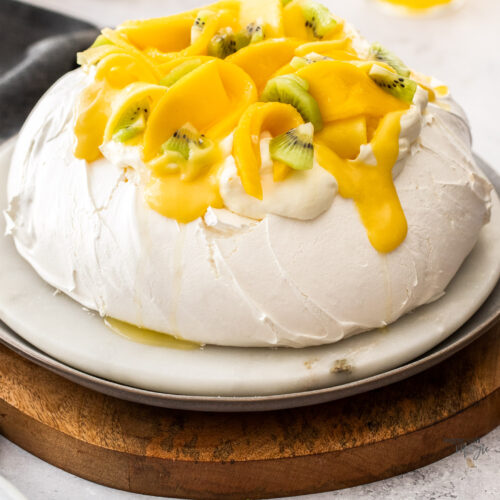


2 Comments on “Mango Pavlova”
This Pavlova is absolutely gorgeous! I’ve been looking at your Pavlova recipes and this one caught my eyes. Mine didn’t turn out looking like this but delicious nonetheless.
So happy you love it, Trang 🙂